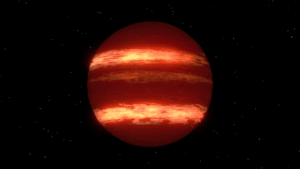Keck Observatory Helps Unravel Mystery of Massive Exoplanets

Artist rendering of a planetary-mass companion. The massive objects look similar to the gas giants like Saturn and Jupiter than inhabit our Solar System. Image credit: NASA/JPL-CALTECH.
A Caltech-led team of scientists are using the W.M. Keck Observatory on Maunakea to answer some puzzling questions about massive exoplanets. Larger than our Solar System’s Jupiter, are they truly planets or “failed” stars known as brown dwarfs?
Massive exoplanets, known as planetary-mass companions, orbit far from their suns and are young enough to glow from the heat of their initial formation. Their glow makes them easier to photograph than smaller exoplanets, which are often outshined by their nearby sun. The question is, are these planetary-mass companions actually planets as we define them, or are they brown dwarfs?
Brown dwarfs form in collapsing clouds of gas in the same way stars do, but lack the mass needed to ignite and shine. The smallest brown dwarfs measure up to the size of Jupiter and look similar to a regular planet orbiting a star.
Researchers have taken a new approach to the mystery by measuring spin rates of three photographed planetary-mass companions and comparing them to spin rates for small brown dwarfs. The results indicate how these massive celestial bodies may have formed.
“These new spin measurements suggest that if these bodies are massive planets located far away from their stars, they have properties that are very similar to those of the smallest brown dwarfs,” says Heather Knutson, professor of planetary science at Caltech and a co-author of the study published in the journal Nature Astronomy.
The study results suggest two possibilities: the planetary-mass companions could actually be brown dwarfs, or these companions are planets that ended up with spin rates similar to those of brown dwarfs.
Researchers think that both newly forming planets and brown dwarfs are encircled by miniature gas disks that may be slowing their spin rates. These similar physical forces may result in planets and brown dwarfs having similar spin rates.
“Spin rates of planetary-mass bodies outside our solar system have not been fully explored,” said graduate student Marta Bryan, lead author of the study. “We are just now beginning to use this as a tool for understanding formation histories of planetary-mass objects.”












